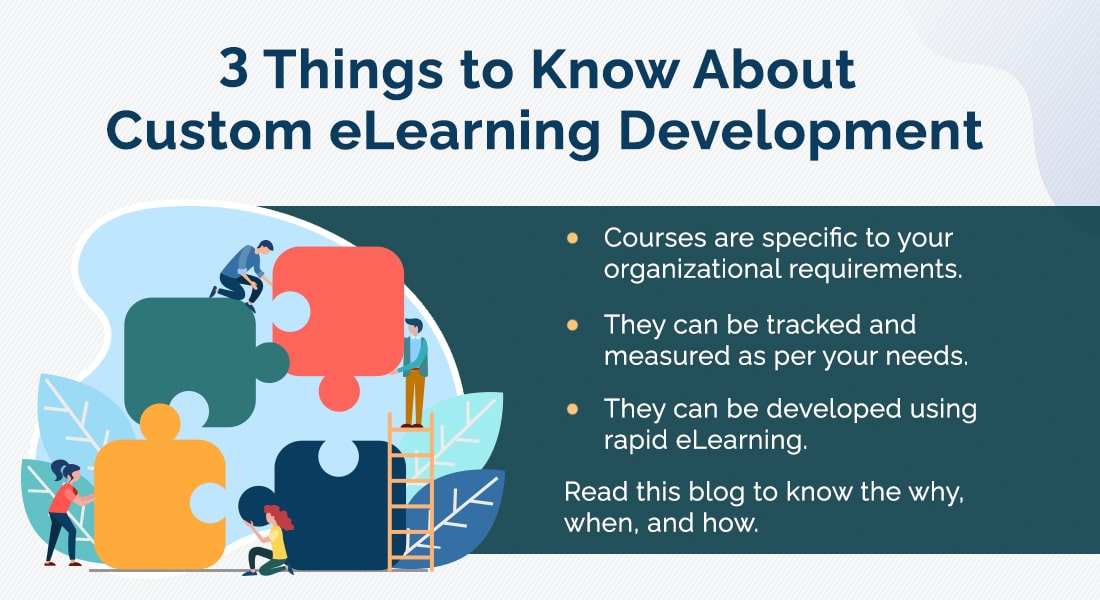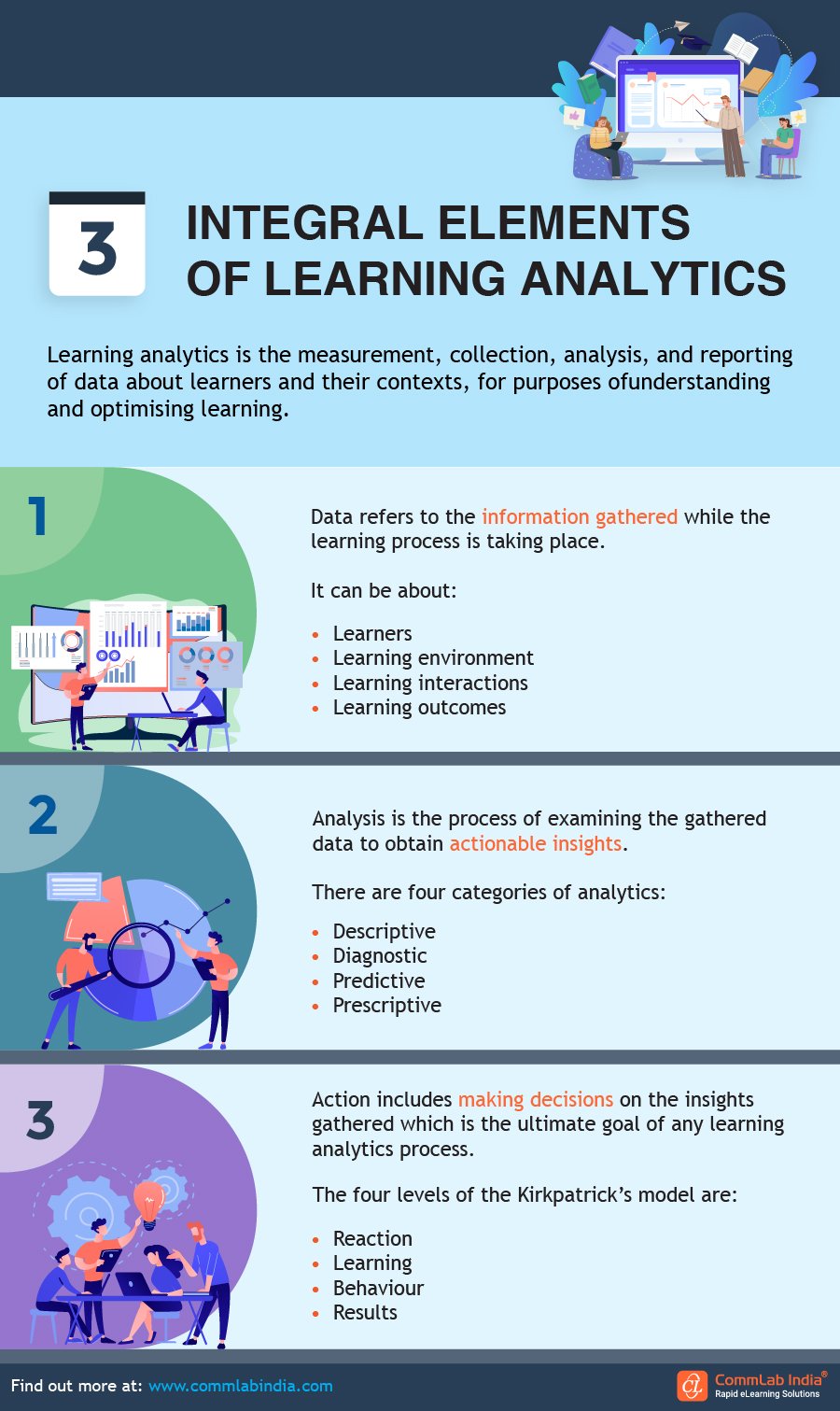The Ultimate Guide to Custom eLearning: Why, When & How to Use It

The month of January means different things for different people. For some corporate organizations, it is the beginning of a new fiscal year; for others, it is the start of the last quarter. But in general, it is a time to tie loose ends and make new plans. And if you are a training manager just coming out of a very difficult 2020, you must be making plans to shift your classroom training to eLearning. If that is so, the question that must be bothering you the most – “Should I place my bet on custom eLearning or go for off-the-shelf courses?”
Custom eLearning for Corporate L&D: Why, When, & How
1. Why prefer custom eLearning over off-the-shelf courses?
Custom eLearning provides eLearning courses tailored to both the learners and organizational goals.
2. When to choose custom eLearning?
When you need custom-designed courses specific to your requirements with longer shelf-life and you have the luxury of time.
3. How can custom eLearning drive your corporate training?
Custom courses aligned to your business goals and learners’ needs can be tracked and measured.
Start your year with a free webinar on the latest eLearning trends and how to adopt them in your plan.
Why Choose Custom eLearning Over Off-the-shelf Courses?
- Do you want to develop training courses that are tailor-made for your organization?
- Do you want training that appeals to your learners and meets their specific learning needs?
- Do you prefer your eLearning courses to have a long shelf-life?
- Would you like to make a one-time investment and reduce future expenses?
If your answer to these questions is ‘yes’, there is no need for you to waste your time searching for off-the-shelf courses. Custom eLearning will give you all that you want and more.
When to Go for Custom eLearning Development?
Custom eLearning will surely give your training an edge over other solutions. But it does need careful planning, a considerable initial budget, and some time for development. It is a long-term investment, and you need to know when to go for custom eLearning and when you can make do with off-the-shelf solutions.
- When you are planning to create training that addresses subject areas, products, or procedures that are very specific to your organization, you should go for custom eLearning. For other types of training, especially mandatory compliance training like POSH or fire safety (which are more or less the same for every organization), you can use off-the-shelf courses if you wish to.
- When there is no urgency to roll out the training courses, think ‘custom’ eLearning. There is no denying that custom eLearning development is time-consuming considering the amount of planning that goes into it, curating the content, designing it according to instructional design principles, and developing it from scratch.
- When the courses are meant to be accessed frequently and don’t need constant updates, go for custom eLearning. For instance, an onboarding custom eLearning solution will be used by thousands of newly hired employees every year. The courses don’t need to be updated every year, and even if some changes are required, you can do them easily, because it will be within your control.
Now that you have some idea on why and when you should go for custom eLearning development, let’s discuss some benefits of custom eLearning and how it can drive your organization’s training initiatives.
Custom eLearning for Corporate Training: 3 Elements to Keep in Mind
1. Align your Courses to Business Goals; Customize Courses to Meet Learners’ Needs
We are well aware that for a successful online training program, courses need to be designed in a way that every aspect, from learning objectives to instructional strategy, is aligned to the organization’s business goals. At the same time, the eLearning course should also address the learners’ needs, be it an intuitive interface, scope of personalization, or flexibility in choosing a learning path.
Meeting these criteria is difficult with off-the-shelf courses as they are designed as one-size-fits-all solutions. But with custom eLearning, you get to design and develop eLearning courses customized to fit whatever requirement you have.
2. Track Learning Activities and Measure Effectiveness at Every Level
Just designing a training program is not enough, measuring its effectiveness is equally important for success. And implementing Learning Analytics effectively may not be possible when you license courses from external Off-the-shelf providers. First, you have to depend on the provider to send you tracking reports. Second, these reports are usually limited to generic parameters like course completion rates and average scores. If you want to add a variety of Key Performance Indicators (KPIs) and measure learning at every level and milestone, you need an eLearning course that is custom-made for your organization.
3. Use Rapid eLearning for Custom eLearning Development
Are you surprised to see rapid eLearning mentioned in a blog about custom eLearning? Don’t be. Though they might seem diametrically opposed to each other, they are closely related. Rapid eLearning is a part of custom eLearning – the only difference is that it involves a few short-cuts to reduce the time and cost of development.
In rapid eLearning, we make use of available content, ready-to-use templates, built-in-interactivities, and stock media from authoring tools. This reduces the need for extensive customization, but it is custom made for your organizational needs, nonetheless. Rapid eLearning can be used for custom eLearning development when you need custom courses for your learning requirements but have a limited budget and/or time.
Summing it Up!
Custom eLearning may sound like a complicated idea, but in reality, it is quite simple. And whatever effort it may require is well worth what you get in return.
However, if you have doubts or lack the expertise or time in your L&D team to customize your eLearning, you can always outsource it to a trustworthy vendor. Here is an eBook with all the information you will need for outsourcing eLearning design and development.
Editor’s note: This post was originally published in February 2021 and has been updated for comprehensiveness.






![What is Custom eLearning — Benefits & Tips for Effective Design [Infographic]](https://blog.commlabindia.com/hubfs/blogs/custom-elearning-benefits-design-tips.jpg)
